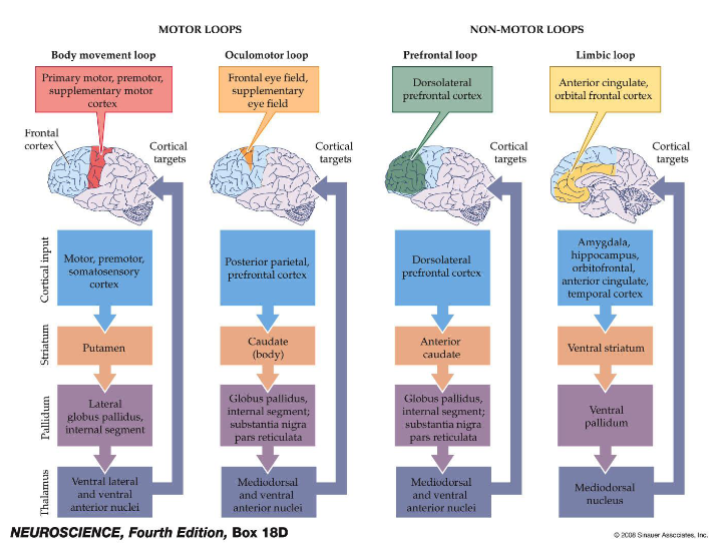Basal Ganglia
1/23
There's no tags or description
Looks like no tags are added yet.
Name | Mastery | Learn | Test | Matching | Spaced |
|---|
No study sessions yet.
24 Terms
What are the main roles of the basal ganglia in movement?
Shape and refine motor activity.
Facilitate a single target movement while broadly inhibiting competing motor activities.
Monitor and coordinate slow, sustained contractions related to posture and support.
Inhibit unnecessary muscle tone throughout the body.
Does the basal ganglia have direct connections to the spinal cord?
No
What are the main input and output structures of the basal ganglia?
Input: Striatum (Caudate & Putamen)
Output: Pallidum (Internal segment of the Globus pallidus (GPi) & Substantia nigra pars reticulata (SNpr))
What other important nuclei are part of the basal ganglia system?
Subthalamic nucleus (STN)
Substantia nigra pars compacta (SNpc)
Globus pallidus (external)
What is the major input nucleus of the basal ganglia?
The striatum.
The general input to the striatum is from what pathway in what part of the brain
Corticostriatal pathway
This brings info from most cortical areas of the brain (excluding auditory & visual) to the striatum (caudate & putamen)
What specific information is brought into the caudate & the putamen (individually)
Caudate input from multimodal association area and motor areas that control eye (I see / eye C)
Putamen input from somatic sensory cortices, premotor & motor cortex, visual & auditory association areas
What input does the striatum receive from the Substantia nigra pars compacta (SNpc)
dopamine
Internal globus pallidus (internal) & SNpr role
Influence motor cortex via inhibition of tonic firing of thalamic nuclei
Prevents spontaneous movements
Control of head movement via superior colliculus
Name the neurotransmitters with an inhibitory & an excitatory function
GABA = inhibitory (GABA baba shhh)
Glutamate = excitatory (excited to see your mate)
What is the basic “loop” of the basal ganglia direct circuit?
Cortex (+)→ Striatum (-)→ Globus Pallidus internal/Substantia Nigra pars reticulata (-)→ Thalamus (+)→ Cortex
What is meant by “thalamus tonically active”?
The thalamus constantly sends excitatory signals to the cortex but is kept under inhibitory control by the basal ganglia output.
What happens during movement initiation in the direct pathway?
(Cortex (+) → Striatum (-) → Globus Pallidus / Substantia Nigra pars reticulata (-) → Thalamus (+) → Cortex)
Cortex excites striatum
Striatum inhibits basal ganglia output
Thalamus is disinhibited
Thalamus excites motor cortex → facilitates movement
How does dopamine affect the direct pathway?
Dopamine from the SNpc acts on D1 receptors in the striatum to enhance this excitatory, movement-facilitating effect.
What is the main function of the indirect pathway?
To suppress competing or unwanted motor programs - providing a broad inhibitory background
Outline the indirect pathway.
Cortex (+) → Striatum (-) → Globus Pallidus externus (-) → Subthalamic nucleus (+) → Globus Pallidus / Substantia Nigra pars reticulata (-) → Thalamus (suppressed +) → Cortex → Movement suppressed.
(thalamus will always have + but here it is suppressed
How does dopamine influence the indirect pathway?
Dopamine acts on D2 receptors in the striatum, which inhibit this pathway — thereby reducing inhibition of movement.
(dopamine wants to increase movement all the time to keep you happy so it inhibits the indirect pathway because it inhibits movement)
What causes Parkinson’s disease?
Loss of nigrostriatal dopamine pathway
Degeneration of dopaminergic neurons in the Substantia Nigra pars compacta (SNpc), leading to loss of dopamine in the striatum.
Results in imbalance within basal ganglia circuitry – ↑ inhibitory outflow from BG
Parkinson’s disease is the 2nd most common neurodegenerative disease. How much of it is caused by genetics
10%
Parkinson's disease symptoms
Movement difficult to initiate and difficult to terminate - Hypokinetic
Dyskinesia: ↓ voluntary and ↑ involuntary movement
Resting tremor
Diminished facial expressions
Reduced arm swing
What type of movement disorder is Huntington’s disease
A hyperkinetic disorder — excessive, involuntary, rapid, jerky movements
What specific neuronal loss occurs in huntington’s disease
Degeneration of medium spiny neurons projecting from the striatum, especially to Globus Pallidus (external).
(Medium spiny neurons projecting from the striatum to the GPe are GABAergic inhibitory neurons that form part of the indirect pathway.
Their function is to inhibit the GPe, thereby increasing thalamic inhibition and suppressing unwanted movements.)
How does degeneration of medium spiny neurons effect the circuitry
GPe becomes overactive → ↓ excitation from STN → ↓ inhibitory output from GPi/SNpr → excess thalamic activation → involuntary movements.
Huntington’s disease (HD) affects four basal ganglia–related loops - what are they?
body movement loop
oculomotor loop
prefrontal loop
limbic loop
